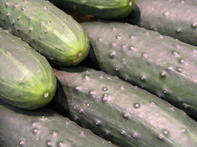
Propagation
Propagation for cucumbers is from seed.Cucumber Planting Method
Open field: The most common way of planting cucumbers is direct seeding and this can be done by hand or by mechanical planters. Planting is also done by transplanting plugs or cucumber seedlings that have been raised in greenhouses.
Greenhouse: Planting cucumbers in greenhouses is done by both direct seeding and by planting transplant. The cheaper way is to plant seeds as the labour cost associated with transplants is higher.
Spacing
Open field cucumber plants should be spaced 30 cm apart in rows that are 100 cm apart. This is about 30 000 plants per hectare. Can be planted to 40 000 plants per hectare. Greenhouse cucumber plants are spaced 30 cm apart in rows that are 120 cm apart.
This is about 30 000 plants per hectare. Under some conditions, up to 60 000 plants per hectare can be planted. Light intensity is very important in high-density plantings. Artificial light is also sometimes used.
Sowing and Planting Time
Open field planting of cucumber seeds and seedlings would be after the last frost, which would be either late August or early September in South Africa. Greenhouse cucumbers can be planted all year round as long as the light penetration is sufficient.Cucumber Growth Period
Good uniform germination requires the soil temperature to be at least 16°C. At 16°C cucumber seedlings take about 14 days to emerge and with a soil temperature of 20°C only 6 to 7 days.
Small baby cucumbers and gherkins are ready for picking about 6 to 8 weeks after emergence. Normal mature sized cucumbers are ready to be picked from 8 to 10 weeks after emergence. Cucumbers develop fast after the first picking so picking must be regular and on time.
Fertilisation
It is always advisable to take representative soil samples of the area that is to be planted. Have the samples analyzed and to follow the recommendation by the crop specialist. A 3:1:5 fertiliser mixture is one of the best for cucumbers because of the cucumber’s Potassium requirement.
Because of the fact that drip irrigation is best for cucumber production the best way to apply the fertiliser is by fertigation (the application of the fertiliser through the irrigation water). This allows the grower to pulse the fertiliser directly to the root zone on a regular basis. The fact that mulching is used by most producers to combat weeds the irrigation would normally be installed before the mulching.
It is important when doing the final preparation of the land and soil to incorporate a pre-plant fertiliser of about 500 kg of 3:1:5 per hectare and 300 kg of superphosphate per hectare into the plant area. This will provide the seedlings with enough nitrogen to establish quickly. It is also very important to establish micronutrient requirements from your soil analysis and match this with the crop requirement. It is important that the plant has enough nutrients when it goes into flower and fruit set. If deficiencies occur this leads to fruit abortions and crop losses.
When the plant starts to spread and form the vine, a further 250 kg of 3:1:5 per hectare can be side-dressed along either side of the plant beds.
After this, a similar nutrient application can take place just before the production period. Foliar feed sprays can be done to supplement microelements. The best way of fertilizing is with liquid fertilisers through the watering systems. Slow release organic fertilisers are also good, providing a continuous supply of nutrients to the plant.
Irrigation
Water application is critical to good production so times of stress should be avoided and in open fields irrigation could be required every two days or daily at times.
Both micro irrigation and drip irrigation can be used but overhead sprinkler irrigation is best avoided because wetting the entire plant makes them susceptible to diseases and could lead to over irrigating.
The best is to use drip irrigation because it saves water, is more precise and fertilisers can be applied more accurately with the irrigation water. This makes everything more accessible to the cucumber plant.
Installing soil moisture measuring instruments is best with such a sensitive crop and allows for accurate and stress-free water management.
By Louise Brodie